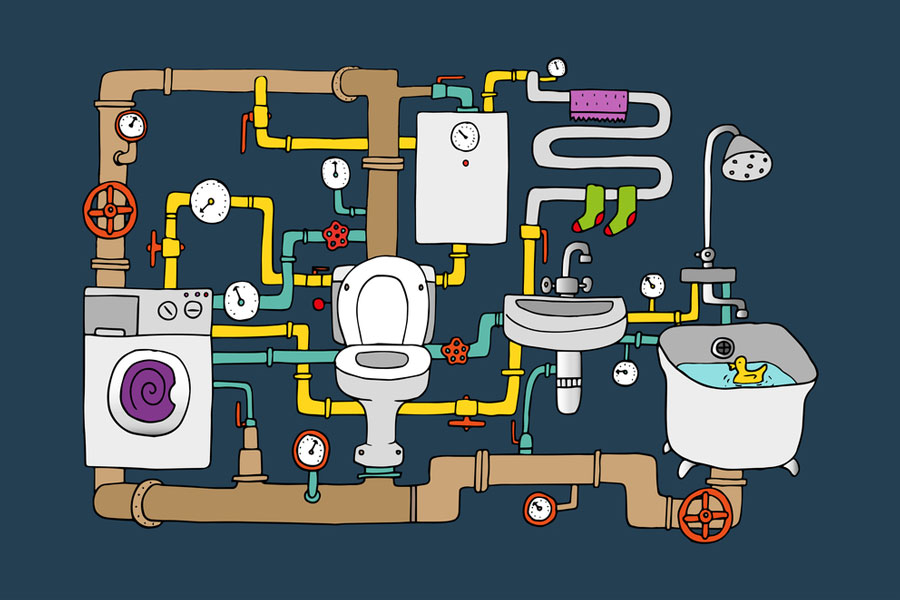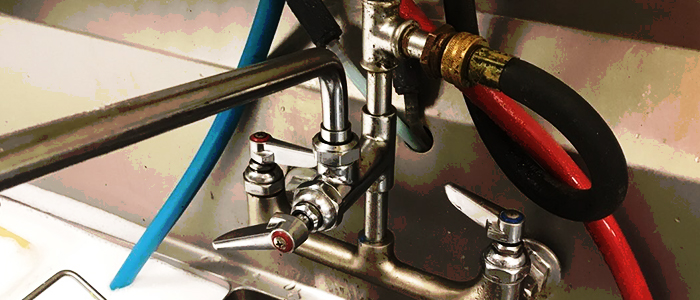The Complete Guide to Your Property's Plumbing System Anatomy
The Complete Guide to Your Property's Plumbing System Anatomy
Blog Article
On this page down the page you will find some good quality content related to Plumbing Installation 101: All You Need to Know.

Understanding how your home's plumbing system works is vital for every homeowner. From providing clean water for drinking, cooking, and bathing to safely eliminating wastewater, a properly maintained pipes system is critical for your family's health and wellness and convenience. In this detailed overview, we'll explore the elaborate network that composes your home's pipes and offer suggestions on upkeep, upgrades, and managing common problems.
Introduction
Your home's pipes system is greater than simply a network of pipes; it's a complex system that ensures you have access to clean water and effective wastewater removal. Understanding its parts and just how they work together can aid you stop expensive repair services and guarantee whatever runs smoothly.
Fundamental Components of a Pipes System
Pipelines and Tubing
At the heart of your plumbing system are the pipes and tubing that lug water throughout your home. These can be made of various materials such as copper, PVC, or PEX, each with its benefits in regards to durability and cost-effectiveness.
Fixtures: Sinks, Toilets, Showers, etc.
Fixtures like sinks, bathrooms, showers, and tubs are where water is used in your house. Recognizing exactly how these fixtures connect to the pipes system assists in identifying issues and preparing upgrades.
Valves and Shut-off Points
Valves control the flow of water in your plumbing system. Shut-off shutoffs are vital during emergency situations or when you need to make repairs, enabling you to isolate parts of the system without interrupting water circulation to the entire house.
Supply Of Water System
Main Water Line
The main water line connects your home to the municipal water supply or an exclusive well. It's where water enters your home and is dispersed to numerous components.
Water Meter and Pressure Regulator
The water meter measures your water usage, while a pressure regulatory authority makes certain that water moves at a risk-free pressure throughout your home's pipes system, protecting against damages to pipes and fixtures.
Cold Water vs. Warm water Lines
Recognizing the difference between cold water lines, which supply water straight from the major, and hot water lines, which carry warmed water from the hot water heater, assists in troubleshooting and preparing for upgrades.
Water drainage System
Drain Pipes and Traps
Drain pipelines bring wastewater away from sinks, showers, and toilets to the sewage system or sewage-disposal tank. Traps protect against sewage system gases from entering your home and likewise trap particles that might cause obstructions.
Air flow Pipes
Air flow pipes allow air right into the drain system, preventing suction that can slow down drainage and cause catches to vacant. Proper air flow is vital for maintaining the honesty of your plumbing system.
Relevance of Appropriate Drainage
Making certain appropriate water drainage avoids backups and water damages. Routinely cleansing drains pipes and maintaining catches can prevent expensive repair work and expand the life of your plumbing system.
Water Furnace
Kinds Of Hot Water Heater
Water heaters can be tankless or typical tank-style. Tankless heating units warm water as needed, while storage tanks save heated water for prompt use.
Just How Water Heaters Connect to the Pipes System
Comprehending just how water heaters attach to both the cold water supply and hot water circulation lines aids in identifying concerns like insufficient warm water or leaks.
Upkeep Tips for Water Heaters
Consistently flushing your hot water heater to get rid of debris, checking the temperature setups, and inspecting for leaks can prolong its life-span and improve energy performance.
Common Plumbing Concerns
Leakages and Their Causes
Leakages can occur because of aging pipelines, loosened fittings, or high water stress. Dealing with leaks immediately protects against water damage and mold growth.
Clogs and Blockages
Blockages in drains pipes and bathrooms are commonly brought on by flushing non-flushable products or an accumulation of grease and hair. Utilizing drainpipe displays and being mindful of what drops your drains can avoid blockages.
Signs of Plumbing Issues to Look For
Low water pressure, sluggish drains pipes, foul odors, or abnormally high water costs are indicators of potential plumbing issues that need to be resolved promptly.
Pipes Upkeep Tips
Normal Inspections and Checks
Schedule annual plumbing assessments to capture concerns early. Seek indicators of leakages, corrosion, or mineral buildup in faucets and showerheads.
DIY Maintenance Tasks
Simple jobs like cleansing tap aerators, looking for bathroom leakages utilizing dye tablet computers, or shielding revealed pipelines in cool environments can protect against significant pipes problems.
When to Call an Expert Plumbing Technician
Know when a pipes problem needs specialist expertise. Trying complicated repairs without correct expertise can bring about more damage and higher fixing prices.
Updating Your Plumbing System
Reasons for Updating
Upgrading to water-efficient fixtures or replacing old pipelines can enhance water high quality, reduce water expenses, and increase the worth of your home.
Modern Pipes Technologies and Their Advantages
Explore technologies like clever leakage detectors, water-saving bathrooms, and energy-efficient water heaters that can save money and decrease environmental impact.
Price Considerations and ROI
Calculate the in advance costs versus long-term financial savings when thinking about plumbing upgrades. Several upgrades spend for themselves with reduced energy expenses and fewer repairs.
Ecological Effect and Conservation
Water-Saving Components and Appliances
Mounting low-flow faucets, showerheads, and commodes can considerably lower water usage without sacrificing efficiency.
Tips for Decreasing Water Usage
Basic routines like repairing leakages quickly, taking much shorter showers, and running full lots of laundry and recipes can save water and reduced your utility costs.
Eco-Friendly Plumbing Options
Take into consideration sustainable pipes materials like bamboo for floor covering, which is durable and green, or recycled glass for countertops.
Emergency Readiness
Steps to Take Throughout a Plumbing Emergency situation
Know where your shut-off valves lie and how to switch off the water in case of a burst pipeline or major leakage.
Importance of Having Emergency Situation Get In Touches With Helpful
Maintain get in touch with details for local plumbing professionals or emergency situation services conveniently available for quick reaction throughout a plumbing dilemma.
Do It Yourself Emergency Fixes (When Suitable).
Momentary solutions like using air duct tape to spot a leaking pipeline or positioning a bucket under a leaking tap can lessen damages till a professional plumbing technician shows up.
Verdict.
Understanding the composition of your home's plumbing system equips you to keep it properly, conserving time and money on repair work. By complying with routine upkeep regimens and remaining informed concerning modern pipes technologies, you can ensure your pipes system runs effectively for many years ahead.
HOW YOUR PLUMBING SYSTEM WORKS
Which Pipes Do What?
Blue lines = fresh water supply entering the building
Red lines = hot water supply entering the building
Grey lines = pipes carrying waste away from the building and venting pipes carrying gases away from the building (through the roof)
YOUR MAIN PLUMBING SYSTEMS
There are two main plumbing systems that support your home s basic plumbing needs one that brings clean water into your home, and one that sends dirty water away from your home. Connected to the toilet, bath, shower, and other faucets in your home, these two systems keep your water flowing in the right directions.
ACCESSING FRESH WATER
Fresh and clean water is brought into your home through the main water supply line . Filtered through one pipe, this water is pressured to flow into the various fixtures in your home at any given time.
This water can be sourced from a well located on your property, a pond or river (mostly cottages), or, as in most cases, from the city s municipal water treatment centre. However, it is important to note that water that is untreated, such as the water siphoned from ponds or rivers, may not be safe to drink. Personal water supplies always need to be treated for hardness and contaminants before consumed.
MUNICIPAL WATER SUPPLIES
Improve taste and odour
Remove sediment
Eliminate hardness
Reduce chlorine
COLD WATER SUPPLY VS. HOT WATER SUPPLY
Cold water flows into your home or building through the service line, which then distributes hot or cold water to your fixtures. This line is most commonly run through a central column that runs floor to floor. Hot water runs in short and straight pipes as the longer the pipeline, the more heat that will be lost in the transfer. Having shorter pipes also allows residents to access hot water more quickly.
WASTE WATER SYSTEM
Your wastewater system is divided into two parts pipes that send wastewater away from your home and venting pipes that send sewer gas away from your home. Sewage water travels through pipes that flush the water and waste towards local sewers that are operated and managed by your city or town. Most sewer systems rely on gravity to move the wastewater to where it needs to go.
The further away from your toilet or sink, the larger wastewater pipes become. This allows for waste to be disposed of from various parts of your home or business at once without pipe blockages. The angle and flow of these pipes are also essential for keeping your waste pipes clear of build up.
https://harrisplumbing.ca/how-your-home-plumbing-system-works/

HOW YOUR PLUMBING SYSTEM WORKS
Which Pipes Do What?
YOUR MAIN PLUMBING SYSTEMS
There are two main plumbing systems that support your home s basic plumbing needs one that brings clean water into your home, and one that sends dirty water away from your home. Connected to the toilet, bath, shower, and other faucets in your home, these two systems keep your water flowing in the right directions.
ACCESSING FRESH WATER
Fresh and clean water is brought into your home through the main water supply line . Filtered through one pipe, this water is pressured to flow into the various fixtures in your home at any given time.
This water can be sourced from a well located on your property, a pond or river (mostly cottages), or, as in most cases, from the city s municipal water treatment centre. However, it is important to note that water that is untreated, such as the water siphoned from ponds or rivers, may not be safe to drink. Personal water supplies always need to be treated for hardness and contaminants before consumed.
MUNICIPAL WATER SUPPLIES
COLD WATER SUPPLY VS. HOT WATER SUPPLY
Cold water flows into your home or building through the service line, which then distributes hot or cold water to your fixtures. This line is most commonly run through a central column that runs floor to floor. Hot water runs in short and straight pipes as the longer the pipeline, the more heat that will be lost in the transfer. Having shorter pipes also allows residents to access hot water more quickly.
WASTE WATER SYSTEM
Your wastewater system is divided into two parts pipes that send wastewater away from your home and venting pipes that send sewer gas away from your home. Sewage water travels through pipes that flush the water and waste towards local sewers that are operated and managed by your city or town. Most sewer systems rely on gravity to move the wastewater to where it needs to go.
The further away from your toilet or sink, the larger wastewater pipes become. This allows for waste to be disposed of from various parts of your home or business at once without pipe blockages. The angle and flow of these pipes are also essential for keeping your waste pipes clear of build up.
https://harrisplumbing.ca/how-your-home-plumbing-system-works/
I ran across that blog entry about Understanding Your Home's Plumbing Anatomy when looking around the search engines. Enjoyed our post? Please share it. Help other people locate it. Thank you so much for going through it.
Call Today Report this page